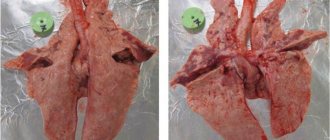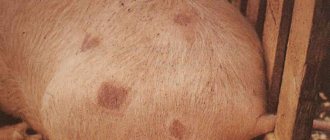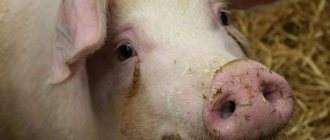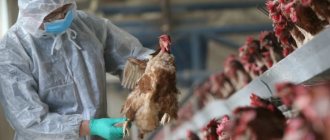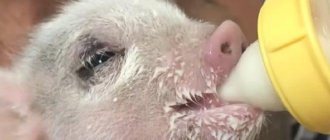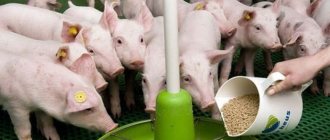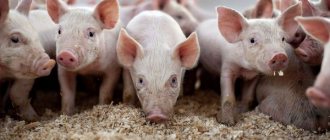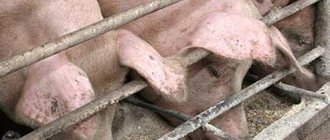Of all the farm animals that farmers raise, pigs are considered one of the least demanding. This concerns, first of all, nutrition. It is believed that piglets eat almost any food, so raising them will be easy. However, this statement is erroneous, since the efficiency of farming depends on the quality of nutrition and the completeness of the diet. In addition, poor nutrition often results in poisoning of pigs, which leads to health problems and even death of the livestock. How piglets can be poisoned, how to avoid such troubles - we share expert recommendations.
Signs of poisoning in pigs
Many veterinarians call poisoning one of the simplest diseases from a diagnostic point of view, since the first symptoms appear in animals almost immediately after eating prohibited or low-quality food. Therefore, the farmer’s main task is to monitor the condition of the livestock and pay attention to any changes in well-being or behavior. Among the warning signs that may indicate intoxication, veterinarians name:
- complete or partial refusal of food;
- weakness, apathy, depression;
- increased activity of the individual, rapid excitability;
- vomit;
- noticeable bloating;
- bowel dysfunction (as a rule, the individual first suffers from constipation, then diarrhea begins);
- the appearance of large amounts of mucus or bloody discharge in the stool;
- increased salivation;
- change in color of mucous membranes;
- gait disturbance (becomes shaky, unsteady);
- a noticeable increase or, conversely, decrease in body temperature;
- dilation or constriction of the pupils;
- the appearance of seizures.
Note that the set of specific signs in a sick individual depends on the type of intoxication. Intoxication of the body is not always accompanied by all of the listed symptoms, since each product in the diet gives its own reaction. Thus, an experienced veterinarian can determine what exactly caused the intoxication based on a set of certain manifestations.
Remember! If an animal exhibits at least one of the listed symptoms, this is a signal for quick action. Pig poisoning is a serious disease that leads to severe intoxication of the body. The weakening of the animal, as a rule, occurs very quickly, so it is necessary to provide assistance to injured individuals without delay.
Viral gastroenteritis
An acute disease that occurs with vomiting, profuse diarrhea, dehydration and a high mortality rate among piglets.
Etiology: the pathogen belongs to the RNA-containing corona viruses. It is very sensitive to light and is quickly destroyed by UV rays. High temperatures also have a detrimental effect on the virus, but at sub-zero temperatures, it remains contagious for up to 3 years.
Epizootology: viral gastroenteritis is dangerous only for pigs, regardless of age and season. Sources of infection are sick and recovered individuals; transmission occurs through the gastrointestinal tract. The population that is more susceptible to the disease is piglets under 2 weeks of age, the mortality rate among them reaches 100%, but piglets that were born from having previously had viral gastroenteritis have immunity for up to 1-2 months of life.
Symptoms: the incubation period in piglets ranges from several hours to 4 days; in adults it can last up to a week.
Symptoms of piglets: profuse diarrhea, vomiting, increased thirst. Body temperature may rise, but soon returns to normal. After 3-6 days, many sick piglets die.
Adult pigs: short-term hyperthermia up to 41 degrees, diarrhea and decreased appetite. Most mature pigs recover; in the rest, it only progresses (vomiting occurs, diarrhea intensifies). Despite complications, mortality among adults can reach 15-20%, the rest recover.
Diagnosis : For a better diagnosis, it is better to call a veterinarian. Viral gastroenteritis is diagnosed taking into account symptoms and epidemiological data.
Treatment: symptomatic therapy only.
Prevention: consists of quarantining newly arrived pigs and keeping the livestock in satisfactory veterinary and sanitary conditions.
2) Parasitic diseases of pigs
A group of diseases that are caused by the action of parasites in the body of an animal, they tend to spread quickly and pass from one pig to the rest. They have peculiarities in the clinical picture, and are treated very well.
Types of poisoning in pigs
If one or more individuals exhibit suspicious symptoms, it is worth analyzing them carefully to find out what poisoned the pig. The answer to this question will allow, firstly, to provide assistance to the injured animals. And secondly, understanding the reasons for poor health will help protect the livestock in the future, as well as reduce the risk of re-intoxication.
There are several reasons why pigs on a farm can become poisoned. Therefore, experts identify the main types of poisoning depending on the animal’s diet:
- Tubers (potatoes, beets). Potatoes themselves are not harmful to pigs if the recommended daily intake is followed. However, spoiled or green tubers can cause poor health. The first signs appear on the second day. This may be increased salivation, vomiting, diarrhea, while the body temperature remains normal. Similar symptoms occur when piglets are poisoned by beets if they were improperly boiled or steamed. When cooled slowly, beets become poisonous and can even lead to the death of livestock.
- Poisoning pigs with rat poison. This is a common cause of weakness and lack of appetite in animals. If the process of poisoning rodents in a pigsty was carried out without observing safety standards, not only the rats, but also the livestock suffer. In addition to drowsiness, after eating rat poison, piglets experience bloody vomiting or diarrhea.
- Plants. Poisonous plants can get into the feeders along with freshly cut grass. They have a negative impact on the body, affecting the functioning of certain organs and systems. Henbane and wormwood cause cramps, spurge disrupts the digestive system, rapeseed and mustard cause shortness of breath and cough, lupins and ragworts affect the liver and cause jaundice.
- Protein poisoning of pigs. Associated with an excess of protein foods in the diet, usually soy. This is a relatively mild degree of intoxication, which is accompanied by weakness. Body temperature does not change, appetite disappears.
- Poor quality food. To ensure a balanced and safe diet, it is important to follow food storage rules and not give animals food that has already spoiled. Otherwise, rot and pathogenic microorganisms will cause vomiting, stool disturbances, weakness, increased body temperature and other signs of intoxication of the body.
- Salt poisoning in pigs. Table salt should be included in the herd's diet, but in limited quantities. Exceeding the daily norm over 3.7 grams per kilogram of weight threatens salt poisoning. The animal begins to vomit, become very thirsty, and has an increased heart rate. With severe intoxication, convulsions are observed.
What to do if a suckling pig burps: prevention
The list of viral and bacterial infections of various etiologies that cause vomiting in suckling piglets is not limited to the diseases listed and described. It is difficult to talk in detail about each disease in one article.
Therefore, pig farmers should know : if a piglet vomits, this is a serious signal for examining the entire livestock and taking emergency measures to improve sanitary standards.
Without the help of a veterinarian, it is difficult to diagnose each infection, as well as to independently choose the right treatment tactics or decide on its advisability in general.
Be sure to read:
Why the piglet's ears turned blue: causes, dangerous diseases and treatment methods.
This is also due to the structural features of the digestive system of newborn piglets.
Hydrochloric acid appears in the gastric juice of a piglet 20-30 days after birth. It is involved not only in the digestion of food, but also protects animals from the effects of pathogenic microflora that enter the stomach along with colostrum or sow's milk.
It is believed that suckling piglets receive immunity thanks to their mother's milk, and this is partly true.
But the stomach of pigs is designed in such a way that digestion begins almost immediately from the moment of feeding, and if the sow is a carrier of a virus that is transmitted with milk, then the piglets simply do not have time to develop immunity. In addition, piglets, like adults, are sensitive to stress, and they experience it at the time of birth. This picture significantly weakens the body's resistance in the first hours of life.
Therefore, the only way out is to vaccinate sows and newborn piglets with the obligatory provision of a safe epidemiological environment in the pigsty and compliance with rearing technology.
Methods of treating poisoning
One of the first questions that arises for farmers who experience pig poisoning is how to treat the animal. The answer depends on the nature of the intoxication and the foods or substances that caused it. In general, there are several types of first aid for injured individuals:
- gastric lavage - most often a solution of potassium permanganate is used for this;
- laxative oils – to remove toxins from the body;
- drinking milk - for example, in case of potato poisoning;
- introducing herbal decoctions into the diet - for example, with an excess of table salt;
- administration of medications - for example, calcium gluconate intramuscularly as prescribed by a doctor;
- the use of antidotes subcutaneously or intramuscularly - usually for intoxication from chemicals;
- the use of cardiac or restorative drugs to increase the body's defenses;
- adherence to the diet until the individual recovers completely.
Note! Even if the farm owner independently diagnoses pig poisoning, symptoms and treatment should be monitored by a specialist. The help of an experienced veterinarian will save time and quickly get animals back on their feet. Self-medication without consulting a doctor can lead to deterioration of the condition and even death of the herd.
Prevention of poisoning in pigs
So that the farm owner does not have to look for what to give a pig in case of poisoning and how to alleviate the animal’s condition, it is important to take preventive measures in a timely manner. Let's divide them into three main recommendations:
- Monitor your daily diet. This point involves monitoring everything that animals eat every day. Canned vegetables, salted fish, poisonous plants, vegetables and fruits that have undergone chemical treatment against pests - all this threatens serious disorders in the body.
- Control the quality of products. Even slightly spoiled food must be disposed of, and under no circumstances should it be offered to animals. The ingress of mold and other microorganisms causes disruption of the intestinal tract and can also lead to irreversible consequences.
- Give special medications to increase the body's protective functions. Farmers have a large number of adsorbents with different properties to choose from. Experts have developed their own composition that helps neutralize the effects of mycotoxins. The complex drug "Simbitox" is suitable not only for the prevention of poisoning of various origins, but also for the treatment of affected individuals. The complex has undergone numerous studies that have confirmed its safety and effectiveness.
Thus, you can fight intoxication using different methods. However, we should not forget that it is always easier to prevent a problem by providing animals with a balanced, high-quality diet than to risk the entire herd and treat the consequences of intoxication.
Pig mug
The disease is contagious for both animals and humans. It is characterized by the development of septicemia, a form of sepsis. The causative agent of the disease is a bacillus that is very resistant to influence. It can live for a long time on a dead animal, in its secretions, or in the soil. Preserved by salting and cold smoking of meat.
The incidence of erysipelas is highest in pigs aged six months to one year. Infection comes from sick pigs, through the skin and food. In the summer, airborne infection is possible through droplets. The pathogen can also be transmitted through bedding and pig care items.
The incubation period is up to 4 days. The acute course is characterized by vomiting, high fever, and intestinal atony. On the 2nd day the animal becomes covered with red spots, the color of which later becomes brownish-red. This course ends in death.
The subacute course is characterized by high fever and weakness. The animal's skin is covered with dark red spots rising above the surface of the skin. If the disease progresses favorably, the spots disappear with the formation of foci of necrosis. Recovery is usually within 12 days.
Complications of the disease are endocarditis, arthritis, necrosis.
For treatment, antibiotics and serum against the causative agent of erysipelas are used, and wounds are treated with streptocide. The diet of a recovering pig should be rich in protein and vitamins.
Prevention of disease: administration of vaccines, rodent control and disinfection of premises and territory with conventional disinfectants.
